2018-11-29 - Nº 187
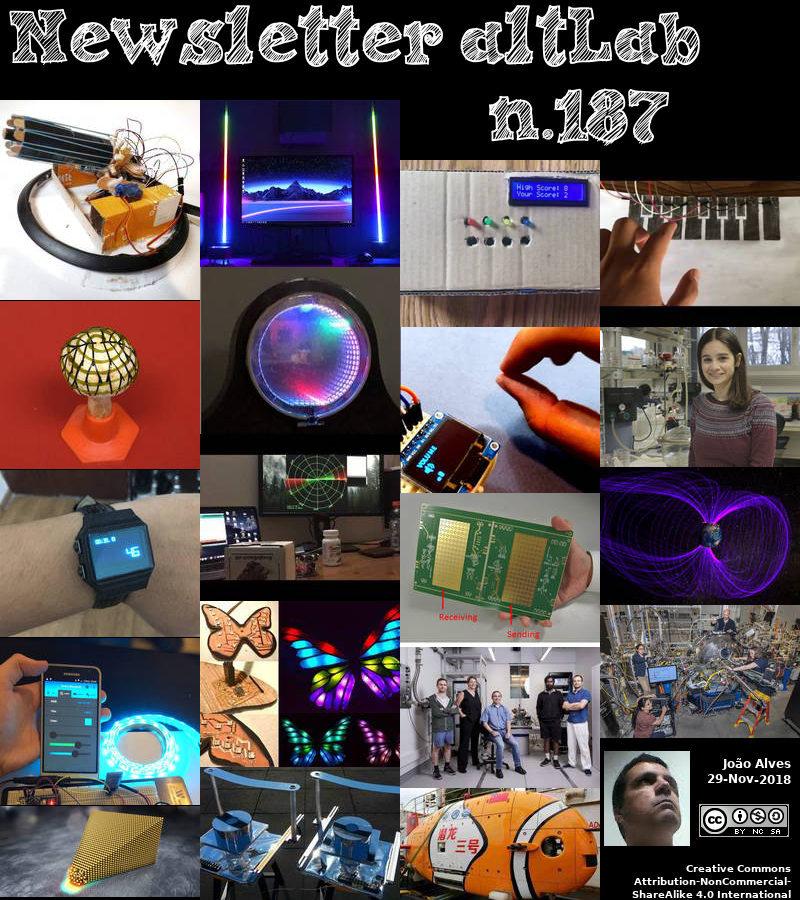
Editorial
Esta é a Newsletter Nº 187 que se apresenta com o mesmo formato que as anteriores. Se gostar da Newsletter partilhe-a!
Todas as Newsletters encontram-se indexadas no link.
Esta Newsletter tem os seguintes tópicos:
Faz hoje anos que nascia, em 1803, Christian Doppler. Este físico austríaco descreveu pela primeira vez como a frequência observada de luz e ondas sonoras é afetada pelo movimento relativo da fonte e do detector, conhecido como efeito Doppler. Em 1845, para testar sua hipótese, Doppler usou dois conjuntos de trompetistas: um conjunto estacionário numa composição de comboio e um conjunto em movimento num vagão aberto, todos com a mesma nota. Quando o comboio passou pela estação, era óbvio que a frequência das notas dos dois grupos não correspondia. As ondas sonoras teriam uma frequência mais alta se a fonte estivesse se movesse em direcção ao observador e uma frequência menor se a fonte estivesse a afastar-se do observador. Edwin Hubble usou o efeito Doppler da luz de estrelas distantes para determinar que o universo está a expandir-se.
Faz também anos hoje que nascia, em 1849, John Ambrose Fleming. Este engenheiro inglês fez inúmeras contribuições para eletrónica, fotometria, medições eléctricas e telegrafia sem fio. Em 1904, ele descobriu o efeito de uma corrente direccional entre um eléctrodo positivamente polarizado, que ele chamou de ânodo, e o filamento aquecido num tubo de vidro em vácuo; os electrões fluíram apenas do filamento para o ânodo. Fleming chamou o dispositivo de díodo porque continha dois eléctrodos, o ânodo e o filamento aquecido. Ele notou que quando uma corrente alterna era aplicada, apenas as metades positivas das ondas eram passadas - isto é, a onda era rectificada (de AC para DC). Também era possível usar uma onda de frequência de rádio e produzir corrente DC correspondente ao ligar e desligar os sinais transmitidos pelo código Morse.
Faz igualmente anos hoje que nascia, em 1874, António Egas Moniz. Este médico neurologista Português foi o fundador da neurocirurgia moderna. Na década de 1920, ele foi pioneiro na técnica da angiografia cerebral, permitindo o exame de raios X das artérias no cérebro. Na década de 1930, ele desenvolveu a forma original de leucotomia pré-frontal (lobotomia), uma operação para aliviar sintomas graves de doença psiquiátrica. A operação consistia em inserir uma faca afiada no lobo pré-frontal do cérebro, aproximadamente a área acima e entre os olhos; exigia o mínimo de equipamento e durava menos de cinco minutos. Devido a este desenvolvimento, ele foi premiado com o Prémio Nobel de Fisiologia ou Medicina de 1949 conjuntamente com Walter Hess.
Por fim, faz anos hoje que nascia, em 1959, Richard Ewen Borcherds. Este matemático britânico ganhou a Medalha Fields em 1998 pelo seu trabalho nos campos de álgebra e geometria, em particular pela sua prova da chamada conjectura de Moonshine. Esta conjectura foi formulada no final dos anos 70 pelos matemáticos britânicos John Conway e Simon Norton e apresenta duas estruturas matemáticas numa relação tão inesperada que os especialistas lhe deram o nome de "Moonshine". Em 1989, Borcherds foi capaz de lançar um pouco mais de luz sobre o contexto matemático deste tópico e produzir uma prova para a conjectura. A conjectura Moonshine fornece uma inter-relação entre o chamado "grupo de monstros" e funções elípticas.
Esta semana ficámos a saber que a sonda Insight da NASA depois de aterrar enviou sinais para a Terra, indicando que seus painéis solares estão abertos e a receber luz solar na superfície de Marte. A sonda Mars Odyssey da NASA retransmitiu os sinais, que foram recebidos na Terra por volta das 17h30. PST (20h30 EST). A implantação de painéis solares garante que a sonda possa recarregar suas baterias todos os dias. A Odyssey também transmitiu um par de imagens mostrando o local de pouso da InSight. Os painéis solares gémeos da InSight têm 2,2 metros de largura cada; quando estão abertos, a superfície inteira é do tamanho de um carro da década de 1960. Marte tem luz solar mais fraca do que a Terra porque está muito mais distante do Sol. Mas a sonda não precisa de muito para operar: os painéis fornecem 600 a 700 watts num dia claro, o suficiente para alimentar um liquidificador doméstico e muito para manter seus instrumentos conduzindo ciência no Planeta Vermelho. Mesmo quando a poeira cobre os painéis - o que provavelmente é uma ocorrência comum em Marte - eles devem ser capazes de fornecer pelo menos 200 a 300 watts.
Na Newsletter desta semana apresentamos diversos projetos de maker. São apresentadas as revstas MagPI 76, a newelectronics de 27 Novembro 2018, a HispaBrick Nº31 e a HackSpace Nº13 de Dezembro.
 João Alves ([email protected])
João Alves ([email protected])
O conteúdo da Newsletter encontra-se sob a licença  Creative Commons Attribution-NonCommercial-ShareAlike 4.0 International License.
Creative Commons Attribution-NonCommercial-ShareAlike 4.0 International License.
Novidades da Semana

InSight Is Catching Rays on Mars
"NASA's InSight has sent signals to Earth indicating that its solar panels are open and collecting sunlight on the Martian surface. NASA's Mars Odyssey orbiter relayed the signals, which were received on Earth at about 5:30 p.m. PST (8:30 p.m. EST). Solar array deployment ensures the spacecraft can recharge its batteries each day. Odyssey also relayed a pair of images showing InSight's landing site. "The InSight team can rest a little easier tonight now that we know the spacecraft solar arrays are deployed and recharging the batteries," said Tom Hoffman, InSight's project manager at NASA's Jet Propulsion Laboratory in Pasadena, California, which leads the mission. "It's been a long day for the team." [...]
Outras Notícias

Hadrian X
"Developed by Fastbrick Robotics Ltd., an Australian robotic technology company, Hadrian X handles the automatic loading, cutting, routing and placement of all bricks, following a computer-aided design, to complete the end-to-end bricklaying of a house in up to 3 days. Delivery of the first commercial prototype is due later in 2017, following a successful proof-of-concept with the Hadrian 105 technology demonstrator in 2015. The Hadrian X is built from steel, aluminium and carbon fibre composites. It is controlled by a network of computers, robot vision cameras, servo motors and a laser tracker that monitors its laying position. According to current performance estimates, the Hadrian X will be able to lay approximately 1,000 bricks per hour, compared to the 300-400 bricks a day that a human bricklayer can place. This, in conjunction with its ability to work 24/7 in any conditions without the need for a break, means that a standard house can be completely built in as little as two or three days." [...]

Volvo Trucks provides autonomous transport solution to Bronnoy Kalk AS
"Volvo Trucks has just signed a landmark agreement with Brønnøy Kalk AS in Norway to provide its first commercial autonomous solution transporting limestone from an open pit mine to a nearby port. The solution for Brønnøy Kalk AS consists of limestone being transported by six autonomous Volvo FH trucks on a five kilometer stretch through tunnels between the mine itself and the crusher. Tests of this solution have been carried out successfully and will continue throughout 2018 to become fully operational by the end of 2019. The agreement follows recent successful automation projects involving mining, sugar cane harvesting and refuse collection. Yet this commercial solution represents an exciting first for Volvo Trucks. Rather than purchasing autonomous trucks, Brønnøy Kalk is buying a transport solution – specifically the transport of the limestone between the two hubs." [...]
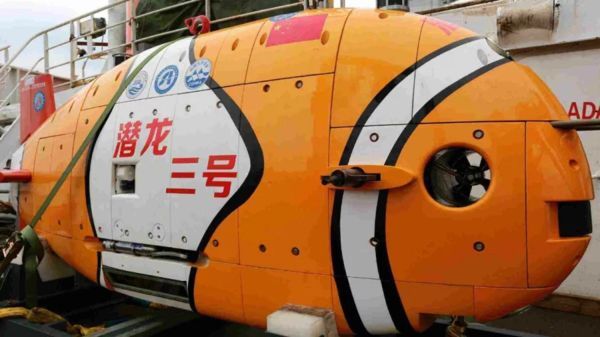
Beijing plans an AI Atlantis for the South China Sea - without a human in sight
"Urged by President Xi Jinping to dare to do something that has never been done before, scientists say challenges could give China huge technology lead China is planning to build a deep sea base for unmanned submarine science and defence operations in the South China Sea, a centre that might become the first artificial intelligence colony on Earth, officials and scientists involved in the plan said. The project – named in part after Hades, the underworld of Greek mythology – was launched at the Chinese Academy of Sciences in Beijing this month after a visit to a deep sea research institute at Sanya, Hainan province, by Chinese President Xi Jinping in April. Xi urged the scientists and engineers to dare to do something that has never been done before. “There is no road in the deep sea, we do not need to chase [after other countries], we are the road,” he said. The idea of an outpost for deep sea exploration has been a favourite of scientists, engineers and fiction writers for hundreds of years, while the Greek allegory of Atlantis has inspired many “city beneath the sea” stories. The Hadal zone that would be home to the base is the deepest part of an ocean – typically a V-shape abyss – at a depth of 6,000 to 11,000 metres (19,685 to 36,100 feet)." [...]

Samsung Electronics Brings Multi-terabyte Storage Capacities at Accessible Price with 860 QVO SSD
"Samsung Electronics, today unveiled its new consumer solid state drive (SSD) lineup — the Samsung 860 QVO SSD — featuring up to four terabytes (TB) of storage capacity with exceptional speed and reliability. Built on the company’s high-density 4-bit multi-level cell (MLC) NAND flash architecture, the 860 QVO makes terabyte capacities more accessible to the masses at approachable price points. “Today’s consumers are using, producing and storing more high-resolution files than ever, including 4K videos and graphics-intensive games, escalating demand for greater capacities and performance in storage devices,” said Dr. Mike Mang, vice president of Brand Product Marketing, Memory Business at Samsung Electronics. “Samsung continues to lead the move toward multi-terabyte SSDs with the introduction of the Samsung 860 QVO, delivering fast performance, reliability and value to more consumers around the world.” Mainstream PC users handling large multi-media content often need to upgrade their PC’s storage to improve everyday computing experience. Based on the commonly used SATA interface and 2.5-inch form factor, the 860 QVO fits perfectly in most standard laptops or desktops. Also, by offering both high capacity and performance in a single, affordable drive, the 860 QVO eliminates the need to use a combination of an SSD and an HDD for booting and storage." [...]
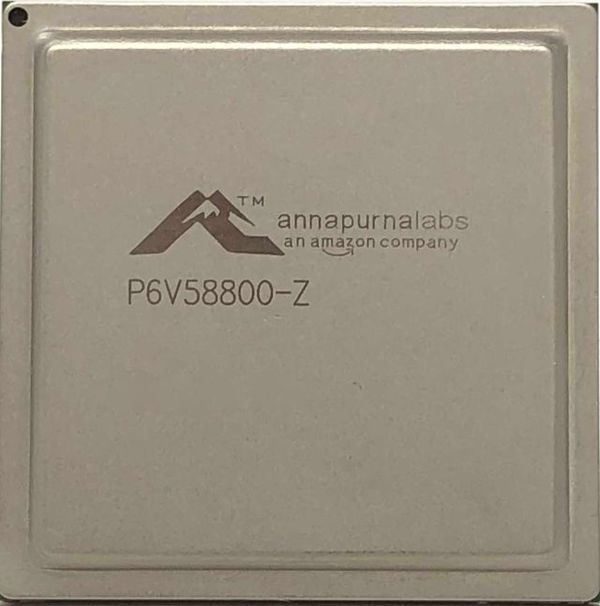
Amazon Web Services Announces 13 New Machine Learning Services and Capabilities, Including a Custom Chip for Machine Learning Inference, and a 1/18 Scale Autonomous Race Car for Developers
"New Amazon SageMaker capabilities make it easier for customers to build, train, and deploy models; SageMaker Ground Truth produces high-quality labeled training data, SageMaker RL delivers cloud’s first managed service for reinforcement learning algorithms and simulators, and a new machine learning marketplace offers more than 150 new models and algorithms to developers through Amazon SageMaker AWS DeepRacer, a 1/18th scale autonomous racing car, which gets developers rolling with reinforcement learning Amazon Elastic Inference reduces cost of machine learning predictions by 75%; TensorFlow enhancements and New Amazon EC2 P3dn instances drive faster machine learning training; new custom machine learning inference chip, AWS Inferentia, will drastically reduce costs New AI services bring intelligence to every app and developer; Amazon Textract extracts text and data from virtually any scanned document; Amazon Personalize and Amazon Forecast bring the same technology used by Amazon.com to developers, with no machine learning experience required; Amazon Comprehend Medical provides natural language processing for medical information Initial customers for these services include Adobe, Alfresco, BMW, Bristol Myers Squibb, Chick-fil-A, Expedia, Formula 1, Fred Hutch Cancer Institute, Intuit, Johnson & Johnson, Lion Foods, Major League Baseball, National Football League, Pinterest, Ralph Lauren, Roche Pharmaceuticals, Samsung, Shell, Siemens, Snap, Thompson Reuters, T-Mobile, Tyson Foods, Woolworths, Zendesk, Zocdoc and more Today at AWS re:Invent, Amazon Web Services, Inc. (AWS), an Amazon.com company (NASDAQ: AMZN), announced 13 new machine learning capabilities and services, across all layers in the machine learning stack, to help put machine learning in the hands of even more developers. AWS introduced new Amazon SageMaker features making it easier for developers to build, train, and deploy machine learning models – including low cost, automatic data labeling and reinforcement learning (RL). AWS revealed new services, framework enhancements, and a custom chip to speed up machine learning training and inference, while reducing cost. AWS announced new artificial intelligence (AI) services that can extract text from virtually any document, read medical information, and provide customized personalization, recommendations, and forecasts using the same technology used by Amazon.com. And, last but certainly not least, AWS will help developers get rolling with machine learning with AWS DeepRacer, a new 1/18th scale autonomous model race car for developers, driven by reinforcement learning. These announcements continue the drum beat of machine learning innovation from AWS, which has launched more than 200 significant machine learning capabilities in the past 12 months." [...]

Fujitsu Develops World's First Single-Panel Antenna to Simultaneously Support Multiple 5G Communications
"Compact base stations can be deployed in stadiums, train stations, other sites Fujitsu Laboratories Ltd. today announced the development of the world's first equipment technology to enable simultaneous communications to four users with a single antenna panel in the 28-GHz band, in the world's most compact structure. The equipment delivers high-speed communications in excess of 10 Gbps, as required by 5G mobile communication formats. The use of 5G is premised on deployment of base stations with comparatively small coverage areas placed every few tens of meters. Given this, it will be necessary to have equipment of a compact size that can be deployed anywhere. Conventional 5G system structures require use of an antenna panel for each terminal when simultaneously transmitting to multiple terminals. Now, by controlling with high accuracy the phase (angle) of signals separately emitted from 128 antenna elements, Fujitsu Laboratories has suppressed the interference between signals." [...]
Ciência e Tecnologia
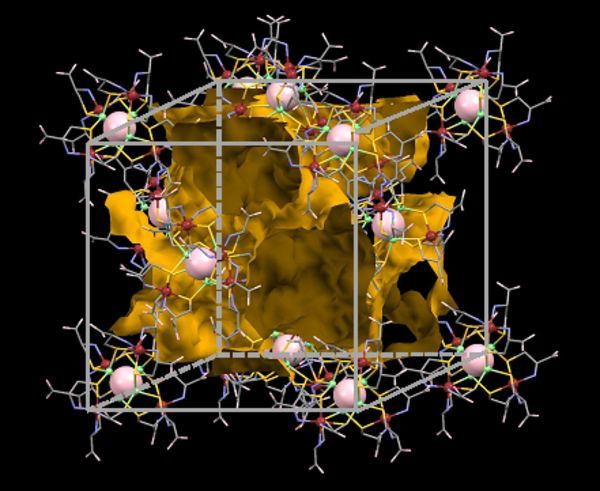
Building Better Batteries by Borrowing from Biology
"A research team at Osaka University has reported a new advance in the design of materials for use in rechargeable batteries, under high humidity conditions. Using inspiration from living cells that can block smaller particles but let larger particles pass through, the researchers were able to create a material with highly mobile potassium ions that can easily migrate in response to electric fields. This work may help make rechargeable batteries safe and inexpensive enough to drastically reduce the cost of electric cars and portable consumer electronics. Rechargeable lithium-ion batteries are widely used in laptops, cell phones, and even electric and hybrid cars. Unfortunately, these batteries are expensive, and have even been known to burst into flames on occasion. New materials that do not use lithium could reduce the cost and improve the safety of these batteries, and have the potential to greatly accelerate the adoption of energy-efficient electric cars." [...]

Silk Adhesive Paves the Way for Epidermal Electronics
"Producing effective epidermal electronics requires a strong, biocompatible interface between a biological surface and a sensor. Here, a KAIST team employed a calcium-modified silk fibroin as a biocompatible and strong adhesive. This technology led to the development of epidermal electronics with strong adhesion for patients who need drug injections and physiological monitoring over a long time. Recently, biocompatible silk fibroins has been increasingly used for flexible substrates and water-soluble sacrificial layers because they allow structural modifications and are biodegradable. From previous studies, the team discovered the adhesive properties of silk fibroin via metal chelate bonding and the water-capturing of Ca ions. Professor Hyunjoo Jenny Lee from the School of Electrical Engineering and her team explored ways to develop reusable, water-degradable, biocompatible and conductive epidermal electronics that can be attached to the human skin for long-term use." [...]
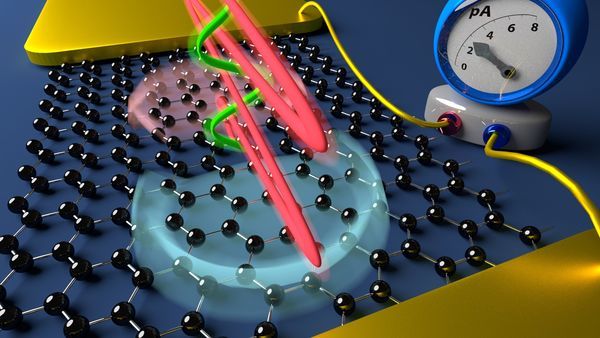
Racing electrons under control
"Physicists at FAU precisely control electrons on a time scale of under one femtosecond Being able to control electronic systems using light waves instead of voltage signals is the dream of physicists all over the world. The advantage is that electromagnetic light waves oscillate at petaherz frequency. This means that computers in the future could operate at speeds a million times faster than those of today. Scientists at FAU have now come one step closer to achieving this goal as they have succeeded in using ultra-short laser impulses to precisely control electrons in graphene. Current control in electronics that is one million times faster than in today’s systems is a dream for many. Ultimately, current control is one of the most important components as it is responsible for data and signal transmission." [...]
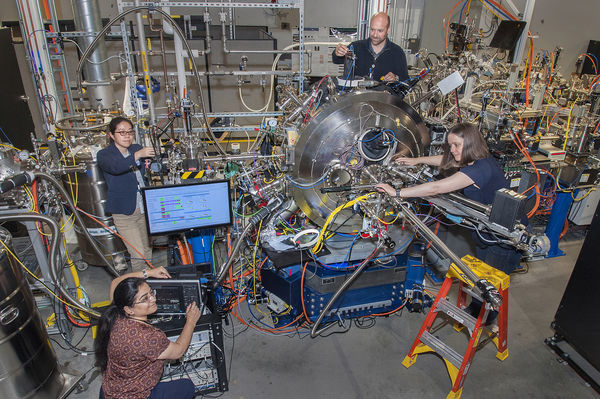
Unlocking the Secrets of Metal-Insulator Transitions
"X-ray photon correlation spectroscopy at NSLS-II's CSX beamline used to understand electrical conductivity transitions in magnetite By using an x-ray technique available at the National Synchrotron Light Source II (NSLS-II), scientists found that the metal-insulator transition in the correlated material magnetite is a two-step process. The researchers from the University of California Davis published their paper in the journal Physical Review Letters. NSLS-II, a U.S. Department of Energy (DOE) Office of Science user facility located at Brookhaven National Laboratory, has unique features that allow the technique to be applied with stability and control over long periods of time. “Correlated materials have interesting electronic, magnetic, and structural properties, and we try to understand how those properties change when their temperature is changed or under the application of light pulses, or an electric field” said Roopali Kukreja, a UC Davis professor and the lead author of the paper. One such property is electrical conductivity, which determines whether a material is metallic or an insulator. If a material is a good conductor of electricity, it is usually metallic, and if it is not, it is then known as an insulator." [...]

Thermoelectric cooling gets fit for micro technology
"Article in nature electronics: Thermoelectric devices become quicker, more reliably and suitable for integration in microchips. Thermoelectric materials can convert heat into electricity or, vice versa, can be used as environmentally friendly cooling elements. In many processes in everyday life and in industry, energy losses occur in form of waste heat, which can be converted by thermoelectric generators into electrical energy. This also provides an additional power source in these systems. Another particularly attractive application of thermoelectric materials is the cooling of microelectronic components, for example in processors or for thermal management in organ implants. For this purpose, thermoelectric generators must be suitable for integration into modern microelectronic systems." [...]
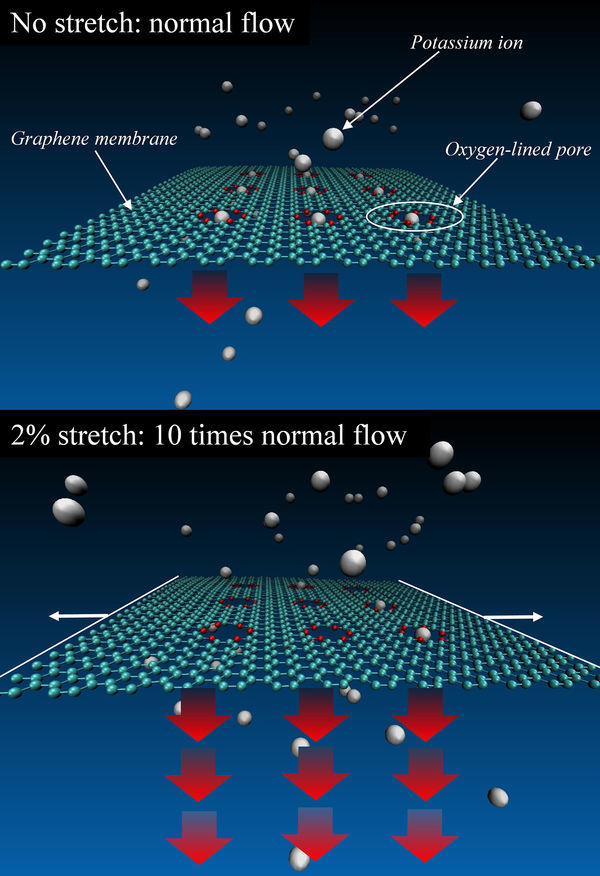
NIST Simulations Suggest Graphene Can Stretch to Be a Tunable Ion Filter
"Researchers at the National Institute of Standards and Technology (NIST) have conducted simulations suggesting that graphene, in addition to its many other useful features, can be modified with special pores to act as a tunable filter or strainer for ions (charged atoms) in a liquid. The concept, which may also work with other membrane materials, could have applications such as nanoscale mechanical sensors, drug delivery, water purification and sieves or pumps for ion mixtures similar to biological ion channels, which are critical to the function of living cells. The research is described in the November 26 issue of Nature Materials. “Imagine something like a fine-mesh kitchen strainer with sugar flowing through it,” project leader Alex Smolyanitsky said. “You stretch that strainer in such a way that every hole in the mesh becomes 1-2 percent larger. You’d expect that the flow through that mesh will be increased by roughly the same amount." [...]
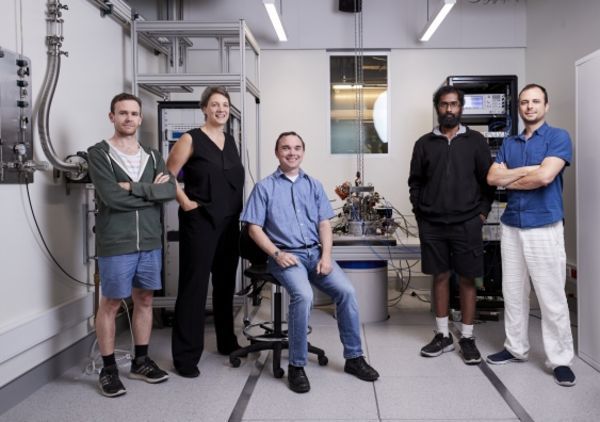
Quantum computing at scale: Australian scientists achieve compact, sensitive qubit readout
"A group led by Australian of the Year, Professor Michelle Simmons, has overcome another critical technical hurdle for building a silicon-based quantum computer. Professor Michelle Simmons’ team at UNSW Sydney has demonstrated a compact sensor for accessing information stored in the electrons of individual atoms – a breakthrough that brings us one step closer to scalable quantum computing in silicon. The research, conducted within the Simmons group at the Centre of Excellence for Quantum Computation and Communication Technology (CQC2T) with PhD student Prasanna Pakkiam as lead author, was published today in the prestigious journal Physical Review X (PRX). Quantum bits (or qubits) made from electrons hosted on single atoms in semiconductors is a promising platform for large-scale quantum computers, thanks to their long-lasting stability. Creating qubits by precisely positioning and encapsulating individual phosphorus atoms within a silicon chip is a unique Australian approach that Professor Simmons’ team has been leading globally. But adding in all the connections and gates required for scale-up of the phosphorus atom architecture was going to be a challenge – until now." [...]
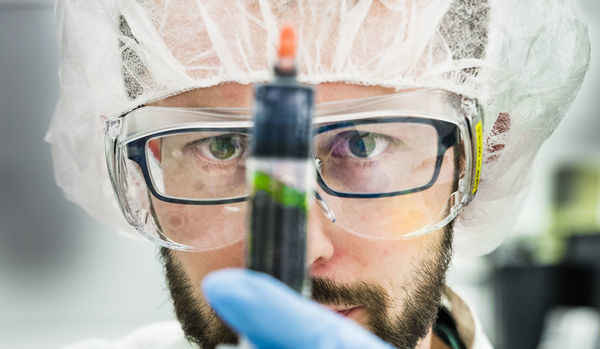
Living electrodes with bacteria and organic electronics
"Researchers at the Laboratory of Organic Electronics, Campus Norrköping, have developed a method that increases the signal strength from microbial electrochemical cells by up to twenty times. The secret is a film with an embedded bacterium: Shewanella oneidensis. Adding bacteria to electrochemical systems is often an environmentally sensitive means to convert chemical energy to electricity. Applications include water purification, bioelectronics, biosensors, and for the harvesting and storage of energy in fuel cells. One problem that miniaturisation of the processes has encountered is that a high signal strength requires large electrodes and a large volume of liquid. Researchers at Linköping University, together with colleagues at the Lawrence Berkeley National Laboratory in Berkeley, California, USA, have now developed a method in which they embed the electroactive bacterium Shewanella oneidensis into PEDOT:PSS, an electrically conducting polymer, on a substrate of carbon felt." [...]

Making it crystal clear: Crystallinity reduces resistance in all-solid-state batteries
"Scientists at Tokyo Tech examined the mechanisms behind the resistance at the electrode-electrolyte interface of all-solid-state batteries. Their findings will aid in the development of much better Li-ion batteries with very fast charge/discharge rates. Designing and improving lithium-ion (Li-ion) batteries is crucial for extending the limits of modern electronic devices and electric vehicles because Li-ion batteries are virtually ubiquitous. Scientists at Tokyo Tech, led by Prof. Taro Hitosugi, had previously reported a new type of all-solid-state battery, also based on lithium ions, which overcame one of the major problems of those batteries: high resistance at the interface between the electrodes and the electrolytes that limits fast charging/discharging. Although the devices they produced were very promising and were much better than conventional Li-ion batteries in some regards, the mechanism behind the reduced interface resistance was unclear. It has been difficult to analyze the buried interfaces in all-solid-state batteries without damaging their layers." [...]

A new way to provide cooling without power
"Device developed at MIT could provide refrigeration for off-grid locations. MIT researchers have devised a new way of providing cooling on a hot sunny day, using inexpensive materials and requiring no fossil fuel-generated power. The passive system, which could be used to supplement other cooling systems to preserve food and medications in hot, off-grid locations, is essentially a high-tech version of a parasol. The system allows emission of heat at mid-infrared range of light that can pass straight out through the atmosphere and radiate into the cold of outer space, punching right through the gases that act like a greenhouse. To prevent heating in the direct sunlight, a small strip of metal suspended above the device blocks the sun’s direct rays. The new system is described this week in the journal Nature Communications in a paper by research scientist Bikram Bhatia, graduate student Arny Leroy, professor of mechanical engineering and department head Evelyn Wang, professor of physics Marin Soljačić, and six others at MIT." [...]
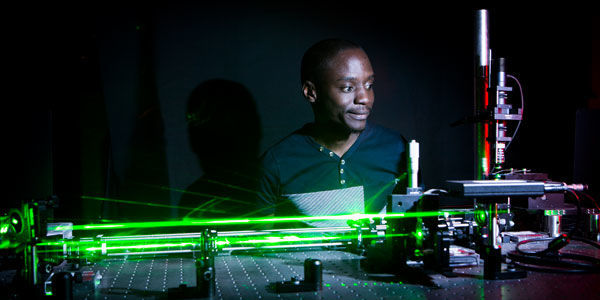
Shedding a new light on optical trapping and tweezing
"Wits physicists demonstrate a new device for manipulating and moving tiny objects with light. When you shine a beam of light on your hand, you don’t feel much, except for a little bit of heat generated by the beam. When you shine that same light into a world that is measured on the nano- or micro scale, the light becomes a powerful manipulating tool that you can use to move objects around – trapped securely in the light. Researchersfrom the Structured Light group from the School of Physicsat the University of the Witwatersrandin Johannesburg, South Africa, have found a way to use the full beam of a laser light, to control and manipulate minute objects such as single cells in a human body, tiny particles in small volume chemistry, or working on future on-chip devices. While the specific technique, called holographic optical trapping and tweezing, is not new, the Wits Researchers found a way to optimally use the full force of the light – including vector light that was previously unavailable for this application. This forms the first vector holographic trap." [...]

A Big Step toward the Practical Application of 3D Holography with High-Performance Computers
"Japanese computer scientists have succeeded in developing a special purpose computer that can project high-quality three-dimensional (3D) holography as a video. The research team led by Tomoyoshi Ito, who is a professor at the Institute for Global Prominent Research, Chiba University, has been working to increase the speed of the holographic projections by developing new hardware. Holography has a long history. Since 1960 when the first laser was invented, many works involving laser holograms have been produced. For digitalizing these analog technologies and developing electron holography techniques to project 3D holography images as video, computing powers with more than 10 frames per second and 1 trillion pixels per frame are required. Therefore, hardware development, as well as corresponding software development, represents some of the biggest challenges for researchers in this field." [...]

Photonic Radiation Sensors Survive Huge Doses Undamaged
"New tests can hasten use of small precision devices in medicine, food safety, spacecraft Researchers at the National Institute of Standards and Technology (NIST) have published landmark test results that suggest a promising class of sensors can be used in high-radiation environments and to advance important medical, industrial and research applications. Photonic sensors convey information with light instead of electric currents in wires. They can measure, transmit and manipulate streams of photons, typically through optical fibers, and are used to gauge pressure, temperature, distance, magnetic fields, environmental conditions and more. They are attractive because of their small size, low power consumption and tolerance of environmental variables such as mechanical vibration. But the general consensus has been that high levels of radiation would modify the optical properties of their silicon, leading to incorrect readings. So NIST, long a world leader in many areas of photonics research, launched a program to answer those questions." [...]

Uber has cracked two classic '80s video games by giving an AI algorithm a new type of memory
"An algorithm that remembers previous explorations in Montezuma’s Revenge and Pitfall! could make computers and robots better at learning how to succeed in the real world. A new kind of machine-learning algorithm just mastered a couple of throwback video games that have proved to be a big headache for AI. Those following along will know that AI algorithms have bested the world’s top human players at the ancient, elegant strategy game Go, one of the most difficult games imaginable. But two pixelated classics from the era of 8-bit computer games—Montezuma’s Revenge and Pitfall!—have stymied AI researchers. There’s a reason for this seeming contradiction." [...]

Sun exposure gets personal with wearable UV sensors
"Managing vitamin absorption and avoiding sun damage could soon be as simple as slipping on a bracelet thanks to new personalised sensors. RMIT researchers have developed an ultraviolet (UV) active ink that changes colour when exposed to different types of UV rays and can be printed and worn as a single use, disposable wrist band. A personal struggle with Vitamin D deficiency led Professor Vipul Bansal to develop the color-changing sensors that come in six variations to reflect the range in human skin tone. Bansal said the discovery could help to provide people with an accurate and simple measure of their personal exposure levels throughout the day. “We can print our ink on any paper-like surface to produce cheap wearable sensors in the form of wrist-bands, head bands or stickers for example,” he said. While humans do need some sun exposure to maintain healthy levels of Vitamin D, excessive exposure can cause sunburn, skin cancer, blindness, skin wrinkling and premature signs of aging." [...]

Putting hybrid-electric aircraft performance to the test
"Although hybrid-electric cars are becoming commonplace, similar technology applied to airplanes comes with significantly different challenges. University of Illinois aerospace engineers are addressing some of them toward the development of a more sustainable alternative to fossil fuels to power airplanes. “Jet fuel and aviation gasoline are easy to store on an airplane. They are compact and lightweight when compared to the amount of energy they provide. Unfortunately, the actual combustion process is very inefficient. We’re harnessing only a small fraction of that energy but we currently don’t have electrical storage systems that can compete with that,” said Phillip Ansell, assistant professor in the Department of Aerospace Engineering in the College of Engineering at the University of Illinois." [...]

A starch and graphene hydrogel geared towards electrodes for brain implants is developed
"Hydrogels with electrical and antibacterial properties suitable for neural interfaces have been created in a piece of work at the UPV/EHU-University of the Basque Country The Materials + Technology research group at the UPV/EHU’s Faculty of Engineering – Gipuzkoa has, in collaboration with the University of Strasbourg, developed some hydrogels with potential biomedical applications. Starch was used as the raw material and a three-dimensional network structure was produced. When graphene and salvia extracts were added, the hydrogel was provided with electrical properties as well as the necessary antibacterial ones. Hydrogels are physical and chemical polymer networks capable of retaining large quantities of liquid in aqueous conditions without losing their dimensional stability. They are used in a whole host of applications and when various components are added to them, they acquire specific properties such as electrical conductivity. This was the path followed by the Materials + Technology research group in the Department of Chemical Engineering and Environment of the UPV/EHU’s Faculty of Engineering – Gipuzkoa, and for its hydrogel they selected a biopolymer that had not been used hitherto for applications of this type: starch." [...]

Researchers Successfully Train Computers to Identify Animals in Photos
"A computer model developed at the University of Wyoming by UW researchers and others has demonstrated remarkable accuracy and efficiency in identifying images of wild animals from camera-trap photographs in North America. The artificial-intelligence breakthrough, detailed in a paper published in the scientific journal Methods in Ecology and Evolution, is described as a significant advancement in the study and conservation of wildlife. The computer model is now available in a software package for Program R, a widely used programming language and free software environment for statistical computing. “The ability to rapidly identify millions of images from camera traps can fundamentally change the way ecologists design and implement wildlife studies,” says the paper, whose lead authors are recent UW Department of Zoology and Physiology Ph.D. graduate Michael Tabak and Ryan Miller, both of the U.S. Department of Agriculture’s Center for Epidemiology and Animal Health in Fort Collins, Colo. The study builds on UW research published earlier this year in the Proceedings of the National Academy of Sciences (PNAS) in which a computer model analyzed 3.2 million images captured by camera traps in Africa by a citizen science project called Snapshot Serengeti. The artificial-intelligence technique called deep learning categorized animal images at a 96.6 percent accuracy rate, the same as teams of human volunteers achieved, at a much more rapid pace than did the people." [...]

Disordered Materials Could Be Hardest, Most Heat-Tolerant Ever
"Computational simulations predict new class of carbides that could disrupt industries from machinery to aerospace Materials scientists at Duke University and UC San Diego have discovered a new class of carbides expected to be among the hardest materials with the highest melting points in existence. Made from inexpensive metals, the new materials may soon find use in a wide range of industries from machinery and hardware to aerospace. A carbide is traditionally a compound consisting of carbon and one other element. When paired with a metal such as titanium or tungsten, the resulting material is extremely hard and difficult to melt. This makes carbides ideal for applications such as coating the surface of cutting tools or parts of a space vehicle. A small number of complex carbides containing three or more elements also exist, but are not commonly found outside of the laboratory or in industrial applications." [...]

Powerful aurora-forming mini explosions seen behind the Earth
"A NASA spacecraft has analysed magnetic explosions on the opposite side of the Earth from the Sun, watching the process that creates auroras. The new study, including researchers from Imperial College London, showed that these events, though small, were fast enough to hurl particles towards the Earth’s upper atmosphere. Here the particles create the auroras, but can also create geomagnetic storms, which can disrupt communications systems on the surface and satellites in space. The Earth is surrounded by a magnetic bubble called the magnetosphere, which protects us from harmful radiation from space. The magnetosphere is defined by magnetic field lines, stretching out into space from the Earth. When magnetic field lines twist and reconnect, an explosive process called magnetic reconnection occurs." [...]
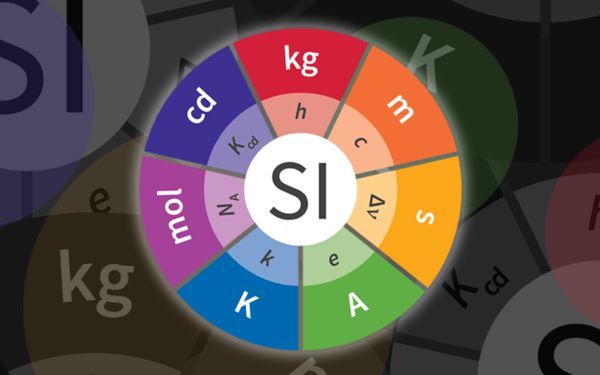
For All Times, For All Peoples: How Replacing the Kilogram Empowers Industry
"Two unusual things happened on Nov. 16, 2018. Fifty-five nations from every continent (except Antarctica) agreed on something, and metrology, the science of measurement, was major news! On that day in Versailles, France, the world’s measurement experts voted to do something momentous. They passed a resolution that specifies the exact values for seven fundamental constants of physics and, in the process, they made it possible for anyone, anywhere to make precise, accurate measurements using the International System of Units (SI), popularly known as the metric system. You may have seen some of the articles with titles like: “The Kilogram is Dead. Long Live the Kilogram!” But wait, you may be thinking, can’t we already make precise, accurate measurements everywhere?" [...]
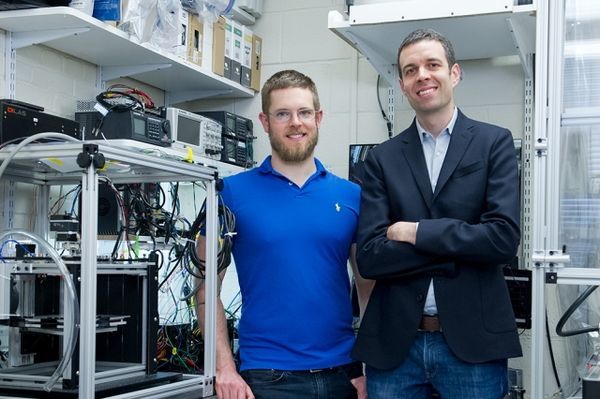
Accelerating 3-D printing
"Researchers have designed a novel printhead that works with unprecedented speed and pioneered ways to melt and extrude renewable materials. Recent work from an MIT lab may help 3-D printing fulfill its long-standing promise to transform manufacturing by enabling the rapid design and production of customized and complex objects. The key to 3-D printing is the printhead, which deposits successive layers of material onto a surface until the final three-dimensional object is complete. The researchers have designed a novel printhead that can melt and extrude material with unprecedented speed, creating a complex handheld object in a few minutes rather than the hour required by a typical desktop 3-D printer. The researchers have also demonstrated a room-temperature process for 3-D printing with cellulose — a renewable, biodegradable alternative to the plastics that are now generally used. To show the chemical flexibility of cellulose, they’ve mixed in an antimicrobial dye and printed a pair of bacteria-resistant surgical tweezers." [...]

A bionic mushroom that generates electricity
"In the quest to replace fossil fuels, scientists are always on the lookout for alternative, environmentally friendly sources of energy. But who could have imagined a bionic mushroom that produces electricity? It sounds like something straight out of Alice in Wonderland, but researchers have now generated mushrooms patterned with energy-producing bacteria and an electrode network. They report their results in the ACS journalNano Letters. Many examples of organisms that live closely together and interact with each other exist in nature. In some cases, this symbiotic relationship is mutually beneficial." [...]

New Device Widens Light Beams by 400 Times, Broadening Possibilities in Science and Technology
"By using light waves instead of electric current to transmit data, photonic chips—circuits for light—have advanced fundamental research in many areas from timekeeping to telecommunications. But for many applications, the narrow beams of light that traverse these circuits must be substantially widened in order to connect with larger, off-chip systems. Wider light beams could boost the speed and sensitivity of medical imaging and diagnostic procedures, security systems that detect trace amounts of toxic or volatile chemicals and devices that depend on the analysis of large groupings of atoms. Scientists at the National Institute of Standards and Technology (NIST) have now developed a highly efficient converter that enlarges the diameter of a light beam by 400 times. NIST physicist Vladimir Aksyuk and his colleagues, including researchers from the University of Maryland NanoCenter in College Park, Maryland, and Texas Tech University in Lubbock, described their work in the journal Light: Science and Applications. The converter widens the cross section, or area of the beam, in two consecutive stages." [...]

How to melt gold at room temperature
"When the tension rises, unexpected things can happen – not least when it comes to gold atoms. Researchers from, among others, Chalmers University of Technology, have now managed, for the first time, to make the surface of a gold object melt at room temperature. Ludvig de Knoop, from Chalmers’ Department of Physics, placed a small piece of gold in an electron microscope. Observing it at the highest level of magnification and increasing the electric field step-by-step to extremely high levels, he was interested to see how it influenced the gold atoms. It was when he studied the atoms in the recordings from the microscope, that he saw something exciting. The surface layers of gold had actually melted – at room temperature. "I was really stunned by the discovery." [...]

Spotting nature's own evolution of quantum tricks could transform quantum technology
"Particles in quantum states defy classic physics by existing in multiple locations at the same time Quantum effects are routinely observed in isolated systems, but more difficult to spot in the ‘noisier’ real world New test could help reveal if nature has evolved to take advantage of quantum mechanics “Observation of quantum effects in a biological system would be tantalizing,” say researchers at the University of Warwick Exploiting use of quantum mechanics in nature could lead to more efficient and powerful quantum technologies in computing, energy, sensing and communications A new test to spot where the ability to exploit the power of quantum mechanics has evolved in nature has been developed by physicists at the University of Warwick. The test identifies a tell-tale hallmark of quantum coherence, classifying the properties of particles in a quantum state that are interacting with a real-world environment. The test should allow scientists to quantify and track quantum coherence in the natural world using laboratory experiments. Published this week in the journal Physical Review A, the theoretical work could lead to experiments that help solve the debate on whether biological processes exploit quantum mechanics to their advantage, and whether evolution could provide us with a template for quantum technologies such as computers, sensors and energy sources. Microscopic particles in a quantum state are very difficult to spot as the act of observing them changes their state. These stealthy particles can exist in many locations or configurations simultaneously, a feature known as quantum coherence." [...]

NIST Atomic Clocks Now Keep Time Well Enough to Improve Models of Earth
"Experimental atomic clocks at the National Institute of Standards and Technology (NIST) have achieved three new performance records, now ticking precisely enough to not only improve timekeeping and navigation, but also detect faint signals from gravity, the early universe and perhaps even dark matter. The clocks each trap a thousand ytterbium atoms in optical lattices, grids made of laser beams. The atoms tick by vibrating or switching between two energy levels. By comparing two independent clocks, NIST physicists achieved record performance in three important measures: systematic uncertainty, stability and reproducibility. Published online today in the journal Nature, the new NIST clock records are: Systematic uncertainty: How well the clock represents the natural vibrations, or frequency, of the atoms. NIST researchers found that each clock ticked at a rate matching the natural frequency to within a possible error of just 1.4 parts in 1018—about one billionth of a billionth." [...]
Documentação
A documentação é parte essencial do processo de aprendizagem e a Internet além de artigos interessantes de explorar também tem alguma documentação em formato PDF interessante de ler. Todos os links aqui apresentados são para conteúdo disponibilizado livremente pelo editor do livro.

The MagPI 76
"With Christmas right around the corner, we thought we’d update our Raspberry Pi beginner’s guide for all the new makers getting a Raspberry Pi under their tree this year. Meet: the Superguide. Plus! We have a full breakdown of the brand new Raspberry Pi 3A+. We’ve got all the benchmarks you’d want, along with an interview with Eben Upton and Roger Thornton on the development of the 3A+. " [...]
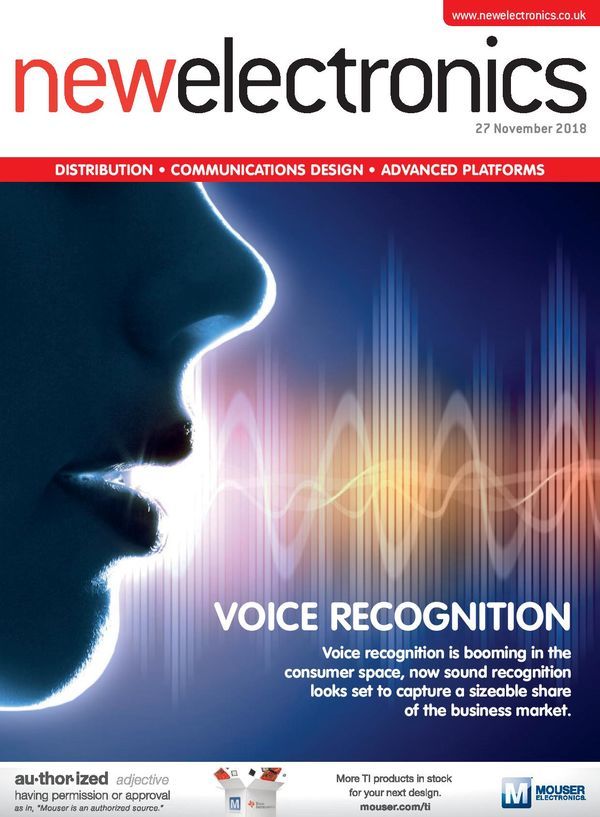
newelectronics 27 Novembro 2018
"New Electronics is a fortnightly magazine focusing on technological innovation, news and the latest developments in the electronics sector. Downloadable as a digital page turner or pdf file, or offered as a hard copy, the New Electronics magazine is available in a format to suit you. " [...]

HispaBrick issue 31
"We are back with another issue of HispaBrick Magazine: number 31. In this issue you can see how AFOLs enjoy events in different countries like Japan, (Japan BrickFest), Chile (Brickfest Chile) or Denmark (LEGO® World Copenhagen). We visit LEGOLAND Japan, Masao Hidaka shows us how you can build a monorail with current LEGO pieces and Julien Ballester tells us about Stuck in Plastic’s annual toy photography safari, this time in the city of París. In our interview section we talk to Jamie Berard, design manager specialist for Creator Expert and LEGO Architecture and we meet Quinten, winner of the 2018 LEGO Ideas Trophy Design Contest. In the KOCKICE Corner we have another instalment of the Minidolls vs Minifigures comparison, a review of LEGO Architecture Skylines and an article about the different animals LEGO has produced. Of course there are also EV3 and Boost tutorials, reviews and much more." [...]

HackSpace magazine #13
"Turn your hobby into a business and start generating cash from your making. Whether you want to earn a little to spruce up your workshop, or are looking for a change of career, we can help you take the plunge. Build circuits with Playdough Make an Arduino from scratch Make spy cufflinks and much much more Wilbur Pan talks about Japanese woodworking" [...]
Projetos Maker
Diversos Projetos interessantes.
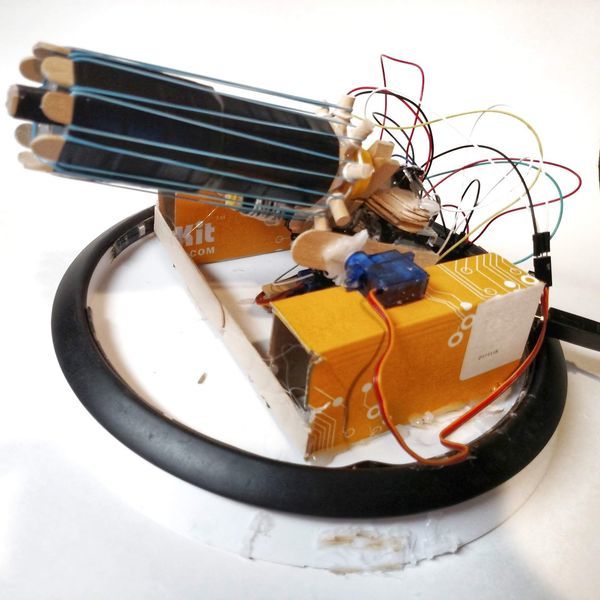
Rubber Band Gatling Gun Turret (Arduino)
"This is an Arduino controlled rubber band Gatling gun. It can hold about 20 rubber bands and it is operated with a USB game controller through processing. The complete bill of materials can be seen below: - Arduino UNO https://amzn.to/2DLjxR2 - Jumper cables https://amzn.to/2Q7kiKc - Breadboard https://amzn.to/2RYqiSK - Servo motors https://amzn.to/2S6E5GZ - Gear motor https://amzn.to/2DQUr3u - Rubber bands https://amzn.to/2S8zgwR - Electrical tape https://amzn.to/2BpvF8a - Lego pieces https://amzn.to/2DROMtU - Craft sticks (big) https://amzn.to/2zldtuH - Craft sticks (small) https://amzn.to/2zldG0X - Hot glue sticks https://amzn.to/2TCRND4 - Binder clips https://amzn.to/2KnZWa3 - Clothespins https://amzn.to/2BpOw2K - Cardboard https://amzn.to/2BpOSGC - Lazy susan https://amzn.to/2OVr4xH - Diode https://amzn.to/2DPaVcn - Dowel rods https://amzn.to/2TycNLd - String https://amzn.to/2r6NkeV - Battery case https://amzn.to/2FBxD9s - Transistor https://amzn.to/2r0RiWm Tools: - Hot glue gun - Screwdriver - Scissors - Drill - Laptop" [...]
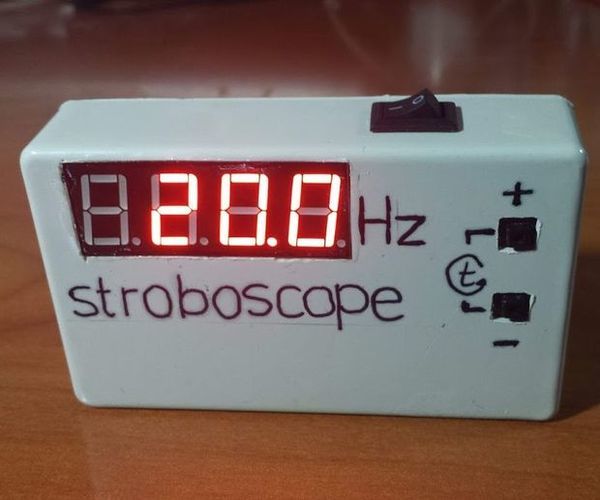
Portable Precision Stroboscope
"The flashing lights of a stroboscope can give amazing hallucinating effects. But precise repetitive flashes of light also allow to visualize motion that is too fast to be seen by eye or by a regular camera. The great video and instructable by GreatScott inspired me to make a portable battery-operated stroboscope with precise frequency control. It turns out that the Arduino is quite capable of doing so, and more so, implementing settable duration of the flashes was quite straightforward too. Precise frequency settings means that a stroboscope can actually be used to make precision measurements of the rotation frequency of a motor, or precision measurements of speed using stroboscopic photography. A simple potentiometer dial is not sufficient to reach permille precision in the frequency setting." [...]

Wireless Music Reactive Floor Lamps
"In this instructable we'll be making some centrally controlled wireless RGB lamps, that responds to music and sounds in the environment! In addition to instructions, the instructable contains: SchematicsList of components Link to the code so you can make and modify your own project" [...]
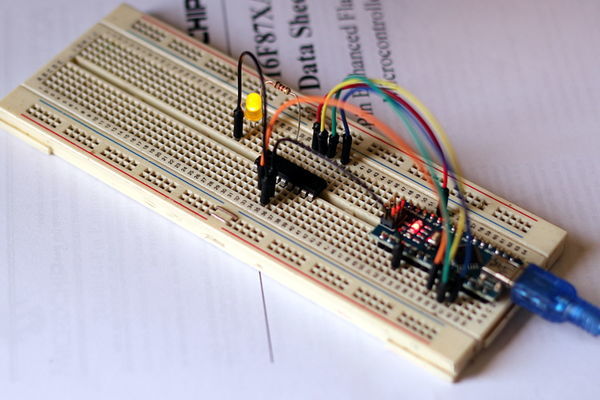
ZEPPP : zero external parts PIC programmer
"A couple of months ago I was asked if I could prepare a sort of workshop on one of my favorite topics: ASM Programming for PIC microcontrollers, which I of course accepted on the spot. Now, I wanted to include a couple of “hands-on” lab sessions in this workshop, and because of this, I needed a way for all attendants to actually work with real PICs that hopefully did not involve purchasing PIC-programming hardware in bulk for what is probably going to be a one-shot activity. The Quest Simple DIY programming circuits exists, and in fact, my first PIC programmer was a home-built “Enhanced” NOPPP (No-Parts PIC Programmer); a fully functional device that required only a couple of components (Not really “No-parts” but pretty close to it). The problem is that it used the PC parallel port (R.I.P), and required an external power supply. And this goes for pretty much every “classic” DIY PIC programming circuit; they all either require extra hardware or can no longer be used on current computers. The main obstacle here is that PIC devices are normally programmed using HVP (High Voltage Programming), which involves using a voltage way above their regular operating level." [...]

Arduino DIY Bluetooth Controller LED RGB Strip
"Hello everybody, this is the second project I want to share with you!Today I will show you how to connect Arduino and Bluetooth module and later use it to control a LED RGB Strip. In this tutorial we will use HC-06 Bluetooth Module, because it is cheap and easy-to-use. (I got mine for 2$ from aliexpress) The Bluetooth module we will use today is HC-06 which is well-known and cheap. (I got mine for 2 from aliexpress)" [...]
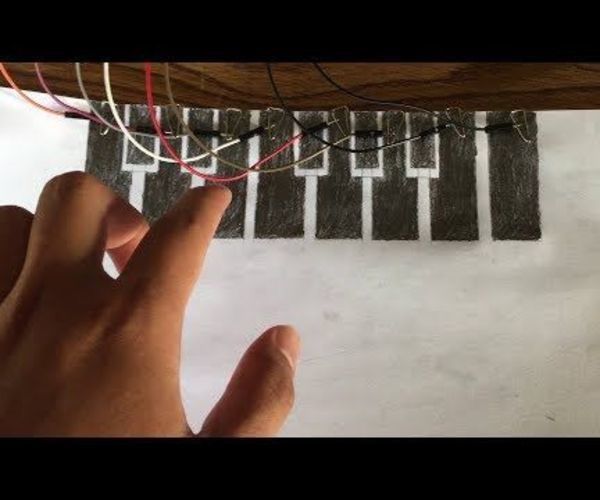
Paper Piano With Arduino
"This is a simple project using an Arduino, a drawn keyboard using lead pencil, a paper, and a speaker. " [...]
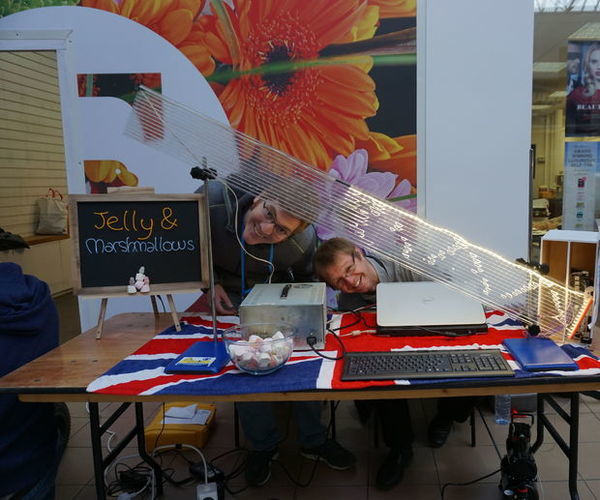
Scrolling Bubble Display
"Have you ever wanted to see you name written in bubbles? Do you have an off-cut of roofing plastic that you don't know what to do with? Do you prefer your text presented in a therapeutically slow and rattly way? If you answered yes to any of these, well this is the project for you! This instructable shows how to make a scrolling bubble message display powered by Arduino. It takes text sent over serial to the Arduino and displays it by writing the letters in bubbles." [...]
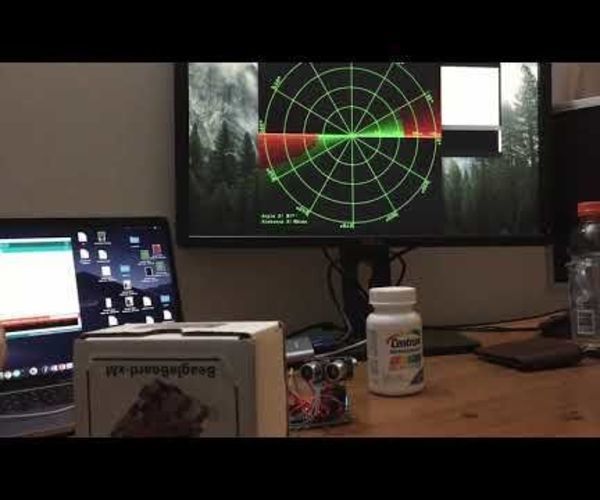
SonarDuino
"Dear fellow Hobbyist, In this project we will explore the possibility of having an 360 degrees radar system for object detection. Having this module set separately will allow your locomotion robot to detect the boundaries of its surroundings. It can also serve as a navigational tool at dark, but only when you walk slow enough ;p To make this build you will need to buy the following : Arduino Nano : https://www.ebay.com/itm/USB-Nano-V3-0-ATmega328-16M-5V-Micro-controller-CH340G-board-For-Arduino/201601613488?hash=item2ef0647eb0:g:DkoAAOSwvYZZpOl0:rk:2:pf:0 Prototyping Boards: https://www.ebay.com/itm/20pcs-set-4Size-Double-Side-Protoboard-Circuit-Universal-DIY-Prototype-PCB-Board/192076517108?epid=506557101&hash=item2cb8a70ef4:g:cQ4AAOSwN~Zbl232:rk:13:pf:0 Servo Motors : https://www.ebay.com/itm/5pcs-POP-9G-SG90-Micro-Servo-motor-RC-Robot-Helicopter-Airplane-Control-Car-Boat/142931003420?hash=item21475a081c:rk:16:pf:0&var Ultrasonic Sensors: https://www.ebay.com/itm/5PCS-Ultrasonic-Sensor-Module-HC-SR04-Distance-Measuring-Sensor-for-arduino-SR04/170897438205?epid=18020663283&hash=item27ca47f5fd:g:w~IAAOSw--xbD5Fp:rk:2:pf:0" [...]

From Webcam to Microscope (EN/FR)
"The purpose of this guide is to explain the basic principle of turning any webcam into a USB microscope. For this proof of concept, i used an old 0,3Mpx Trust webcam (one of the worst webcam possible) and some 3D printed parts. I managed to get 1000X magnification (optical + numerical zoom) but the resolution is only 640x480. You can thus expect a much better images with a more modern webcam. the operating principle is pretty simple : - You take apart an old webcam- You recover the lens and flip it back- Put it back and with the help of magic optical principles you get a working microscope - Finally you just have to design and 3D print somes parts to hold your samples" [...]

Motion and Gesture Detection by Arduino and PIR Sensor
"In this article, we'll show you how to make a gesture detector by simple components like the PIR sensor and Arduino Nano. At the end of this article you can: - Explain PIR sensor applications and how it works - Run an 8-Pixel PIR sensor named TPA81 - Use the PIR sensor to detect motion and gesture by Arduino - Make a cool detector to increase or decrease your speaker volume. A passive infrared sensor (PIR sensor) is an electronic sensor that measures infrared (IR) light radiating from objects in its field of view. They are most often used in PIR-based motion detectors. All objects with a temperature above absolute zero emit heat energy in the form of radiation. Usually, this radiation isn't visible to the human eye because it radiates at infrared wavelengths, but it can be detected by electronic devices designed for such a purpose." [...]
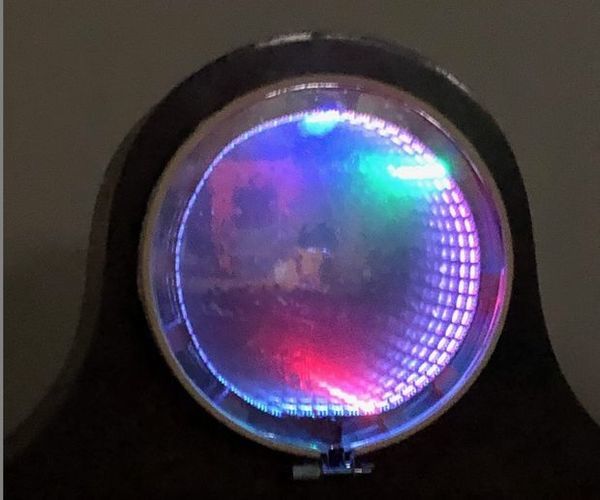
Infinity Clock - Arduino - WS2813 and DS3231
"Infinity Clock - Arduino - WS2813 and DS3231I wanted to build a clock, and liked the idea of trying my hand at making an infinity clock with an Arduino. I wanted it to build it out of common items, and write the program myself. What is an Infinity Clock? The 3D illusion mirror effect is produced whenever there are two parallel reflective surfaces which can bounce a beam of light back and forth an indefinite (theoretically infinite) number of times. The reflections appear to recede into the distance because the light actually is traversing the distance. By adding colored LEDs to the Infinity mirror we attempt to simulate an analog clock using the receding colored light as clock hands." [...]
Headless Raspberry Pi Configuration
"Configuring a Raspberry Pi for headless operation without having to connect a keyboard and a screen, involves the following step - Download the latest Raspbian image - copy the Raspbian image to sdcard - setup Wifi - change pasword for pi - enable sshd - adduser for me, - modify group - add me to sudo - add athorized ssh keys for me on my laptop so i can login without password - set timezone - set hostname - set keyboard - run raspi-config to configure various other stuff Dependent on what it will be used for, there is still more to do, quite a few of the above steps needs to be done on the sdcard before you can access the Raspberry Pi remotely. " [...]
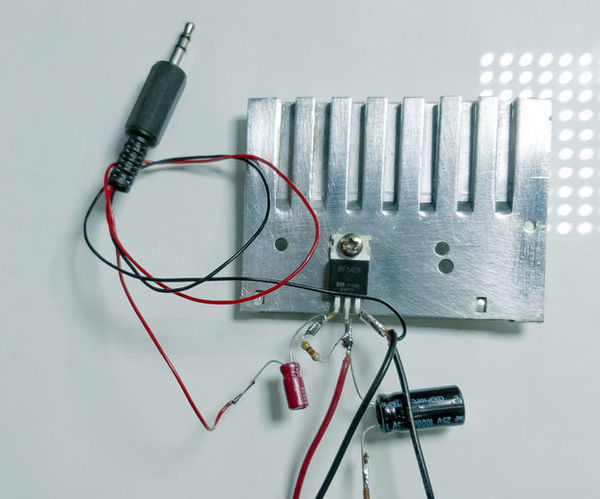
Audio Amplifier | Simple & Powerful
"This amplifier is simple but pretty powerful, it uses just one MOSFET transistor in it. " [...]
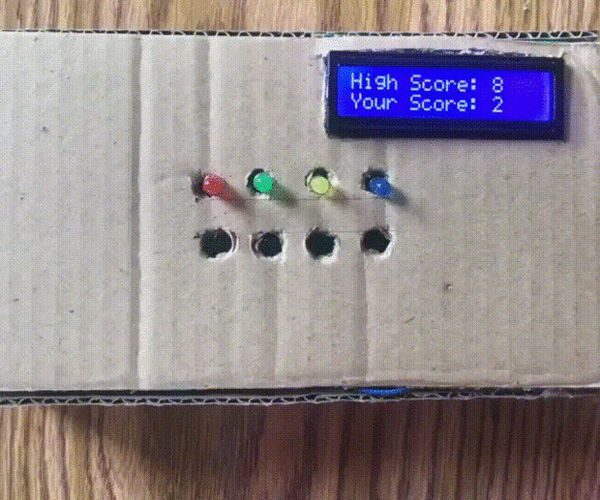
The Memory Game
"If you have a bad memory to remember, Memory game is a greatidea for improving memory and concentration. This game is a Simon based game for the Arduino. This project consists of 4 buttons, 4 LEDs, an Arduino, a LCD and a speaker.In this game you have to follow the pattern of LEDs/notes as long as you can. " [...]
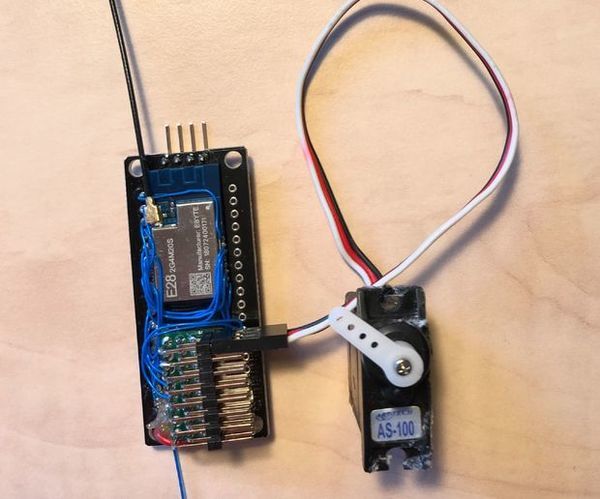
High Resolution PWM Signal Generation for RC Servos With STM32 Devices
"Currently, I'm building an RC transmitter/receiver based on the SX1280 RF chip. One of the goal for the project is that I want 12 bit servo resolution from the sticks all away down to the servos. Partly because modern digital servos have 12 bit resolution secondly a high-end transmitter is using 12 bits anyway. I was investigating how I can generate high resolution PWM signals on STM32 devices. I'm using black pill (STM32F103C8T8) at the moment for the prototype. " [...]

Using Old DVD Drive Lens As Color Detector
"I have many old CD and DVD writer of PC and laptop.I tear down many of them. These employs highly accurate stepper motor(DVD and lens movement) and simple DC motor (For opening and closing tray). I use it for 3D printer and mini CNC machine. But only part it left is circuit board and DVD lens. So i come with new idea to use it in better way.Lets get started!! " [...]
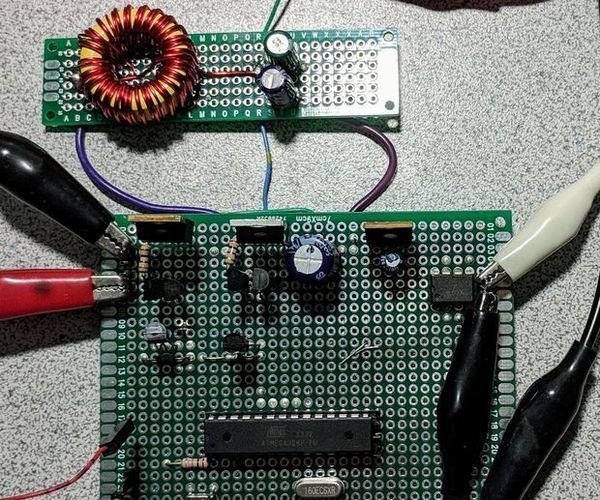
Arduino Powered Bi-directional DC-DC Converter
"This project started as a way to create an universal digitally controlled switch mode power supply module base on the Arduino development platform. As I worked on the design, the platform turn out to be an excellent bi-directional DC-DC converter that has many uses. As the control system is based on a micro controller, all the parameters can be adjusted though changes in the firmware. The basic control loop use a simple integrate operation. This is the I in the PID controller. It is fairly straight forward to add the P and D operation to the control loop, though there should not be any need to add the differential part." [...]
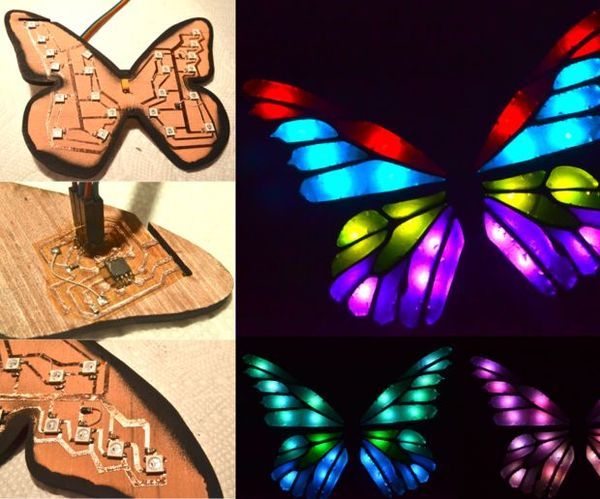
Electric Butterfly
"This is a very cool multi-colored butterfly I made - requires minimal parts and programming! Aside from the butterfly itself - it shows some very cool techniques where you can make your own PCBs on a silhouette home cutter out of regularly commercially available copper tape - which can be placed onto any type of surface! Obviously - something like this could be easily created via a commercially made printed circuit board - but if you want to spare the expense of having one made, you want to create LED patterns over a non-standard material (like a mirror or window, rather than a fiberglass PCB) - or even something with a curved surface - this method can be used to cheaply adhere the copper PCB traces onto just about any kind of surface. This is easily done for things like LEDs which have large lead pitches - but gets harder as you use more fine, smaller pitched parts. So this technique may be used selectively - i.e. use an off-the-shelf board (Arduino) as a computer, and the home-cut copper etches for places where you want extreme customization in placing LEDs." [...]

Sonoff Basic Rebuild to Low Voltage (12V)
"YouTube: https://www.youtube.com/watch?v=Ps6UIzsx5oA&t= Hello guys. Wouldn' t it be nice sometimes to control all your appliences and all your stuff with a WiFi smart switch? But often you don' t need to switch 230V AC. If you create a Short Circuit during wiring theres a risk of an electric shock - This can be very dangerous! I looked for a way to switch on/off my LED Strips using a Sonoff without switching 230V of the power supply. So in this Instructable I'm going to show you how to create your very own WiFi Smart Switch for voltages up to 35V DC using only a few components: -1x Small PCB (I cutted a piece of a 2x8cm PCB) -1x L7805 Voltage Regulator -2x 103 (10nF) capacitor -cables (I used 0.14mm) -Some solder Tools: -Soldering Iron -Rotary Tool, but a cutter would also do the job as fine :) So let' s begin!" [...]

LEAP: Little Electronic and Arduino Projects
"LEAP is my collection of electronics projects, many involving an Arduino in one way or another. Some are full builds like The FretBoard, while many are trivial breadboard kata, intended to test or explore a single idea. Many are variations of things found wild on the net, or inspired by ideas from the sources such as: - Boldport Club - Nuts&Volts magazine - Silicon Chip magazine - Electrical Engineering StackExchange - Arduino StackExchange - Arduino Playground - books from my electronics bookshelf - the many great electronics YouTube channels e.g. - Afrotechmods - Ben Eater - GreatScott! - Julian Ilett - Scullcom Hobby Electronics - w2aew Feel free to borrow liberally, and if you spot any issues do let me know. See the individual projects for credits where due." [...]
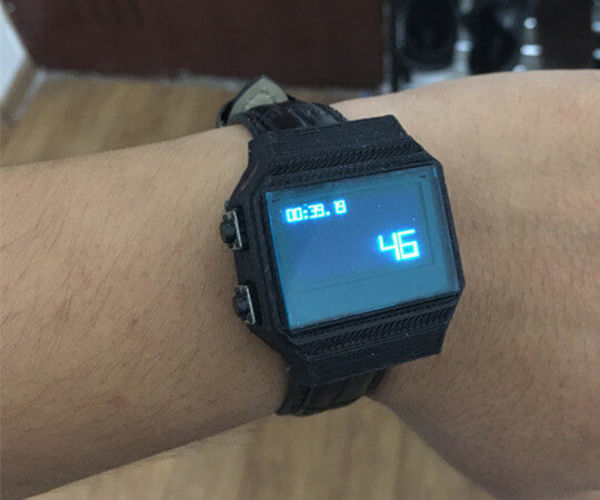
How to Make a Wristband Pedometer
"I am fond of walking and running in the district I live in. I enjoy the time to be alone because some awesome ideas always come to me at this time. Recently I bought a 6-Axis Inertial Motion Sensor from DFRobot. So it occurs to me that why not make a wristband pedometer to calculate my physical strength. I always cannot resist it when the inspiration comes. Ok , let me be straight up and just get started." [...]

Arcade Stick for PC and Raspberry Pi
"Genuine arcade fightsticks are generally expensive. A lot of the more popular ones are made for fighting games and cost around the $200 mark. There are cheaper ones that don't last as long but will still give you a playable experience. But what if you want to go cheaper? There are a large variety of cheap DIY kits on ebay and I decided to make one since I've never used anything more than a controller or keyboard and mouse. I managed to learn a lot more than I expected making this and had some fun doing so." [...]

Servo Maze Controlled by Gyroscope - Arduino
"This arduino project uses a gyroscope to control two servo motors for each axis, rotating the maze with a ball, the objectiv is to complete it fastest. Two years ago a friend and i built a bluetooth maze it used an app on an android device that send the gyroscope data throught bluetooth. this one use an mpu6050 to sense. i ordered an bluetooth module, when it arrives i'll make this version again and i'll upload here. " [...]
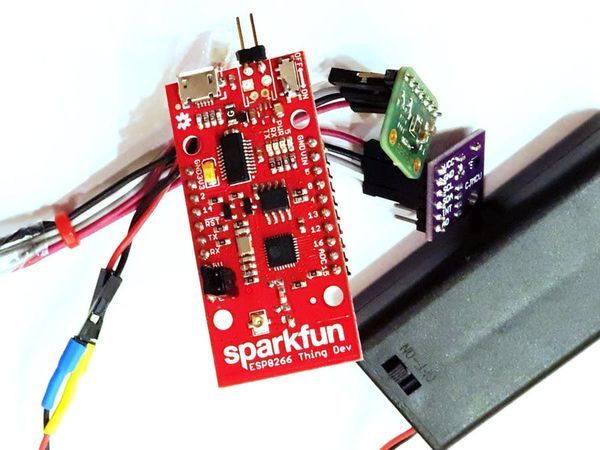
WiFi Air Quality Station
"Yes, yet another weather station. But this one is special! It connects to your WiFi and it can run for more than a year on 2 AA batteries! Story I was very intrigued when the very inexpensive ESP8266 module hit the market. All of a sudden you could add full WiFi functionality to basically any project at a very low price. I was even more intrigued when I read this article about how you can set the module to a very low power state in which it could lay dormant for more than an hour." [...]

How to Build and Flash ESPurna Open Source Firmware to Sonoff POW Wireless Switch
"ITEAD Studio Sonoff family is comprised of various inexpensive ESP8266 WiFi power switch, and the company sent me two of their latest CE certified models with Sonoff TH16 + external temperature & humidity probe, and Sonoff POW to measure power consumption. I checked the hardware is the first part of the review, and used Sonoff TH16 to control a water pump with the stock firmware and Ewelink Android app in the second part. It works reasonably well, but it relies on the cloud, so if you lose your Internet connection or the service closed, you can’t control the relay manually anymore. Luckily, the UART pins are exposed on Sonoff switches so you can solder a 4-pin header and connect a USB to TTL to flash your own firmware. Please don’t connect Sonoff devices to the mains when programming them, it’s very dangerous, instead the USB to TTL board will power the system, and will allow you to program the board safely. Later you’ll be able to update the firmware, if needed, over the network." [...]

Arduino Mega + WiFi = Automation
"Today, Ill talk about an assembly that was suggested by many followers: Arduino Mega + ESP. This will include an automation project with 16 relays, three sensors, and a smartphone. Well make a Web Server for the Arduino Mega using serial communication with the ESP8266, in the ESP-01 version. I will also show a page with the values of sensors and buttons to modify the state of the relays. " [...]
That's all Folks!


